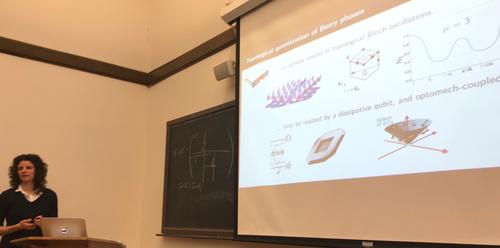
February 27, 2020
On February 21, 2020 Judith Hoeller successfully defended her thesis: “Topological quantization of Berry phases in quantum and classical systems” (Advisor: Nicholas Read).
Hoeller explained “My thesis research could be viewed as a progression of the following basic questions: How does a cat right itself when falling a short distance; how does a long Foucault pendulum rotate its swinging axis over the course of a day; how does a spin rotate as an applied magnetic field is slowly varied? These questions have all been answered using Berry phases. Berry phases describe how quantities can change after a certain time even if we do not notice the change at shorter times.
One part of my thesis describes how a single atom moves in an accelerated optical lattice. For small enough accelerations, the atom is known to undergo Bloch oscillations–a periodic back-and-forth motion–but this periodicity generally breaks down for larger accelerations. I found that lattice symmetries may restore the periodicity even at large lattice accelerations. The atom’s motion may itself be fairly complicated but after a certain time it would recover its initial position because of a quantized Berry phase.
The other part of my thesis is about well-controlled coupled and damped harmonic oscillators. Well-controlled means that there are many parameters that we can tune, such as coupling constants and damping rates. I discovered that this parameter space has high-dimensional submanifolds, on which some or all of the oscillators’ amplitudes are locked to one another. Perturbations away from these submanifolds would drastically increase some amplitudes compared to others. Perturbations that result in closed loops on (or close to) these submanifolds, induce quantized phase shifts–these are again Berry phases–in the oscillation amplitudes after a certain time.”
Hoeller will do a Postdoctoral Associate position in theoretical neuroscience
Thesis Abstract: Berry phases are known to occur for a spin 1/2 in a slowly varying magnetic field in quantum mechanics, and for the polarization of light in a gently twisted optical fiber in classical optics. Such Berry phases take on continuous values. I describe two systems in which Berry phases are topologically quantized to discrete values: (1) cold atoms in accelerated optical lattices, and (2) dissipative two level systems coupled to radiation with a slowly varying phase offset.
(1) Cold atoms in accelerated optical lattices have been used to simulate Bloch oscillations, which would occur for electrons in solids with applied electric fields but usually their relaxation times are too short. Bloch oscillations occur because of the translational symmetry of the lattice, which guarantees that the wave function in one energy band is periodic in quasimomentum. However, crystallographic symmetries of the lattice may entangle multiple energy bands, in which case it becomes questionable if the wave function is periodic at all. I will discuss that it can be–due to a symmetry-quantization of Berry phases–which then results in period-multiplied Bloch oscillations.
(2) A dissipative two level system coupled to radiation could describe two optomechanically coupled normal modes of a dielectric membrane or a microwave-driven superconducting quantum bit. By modeling the dynamics with a non-Hermitian Hamiltonian, we find that for a certain driving frequency and strength, the Hamiltonian is no longer diagonalizable. At such an exceptional point, striking differences to Hermitian dynamics take place. After a transient time, the unique eigenvector locks the relative amplitudes between the two-level states. Additionally, if the phase of such a drive is slowly varied around a cycle, a Berry phase of exactly π is acquired.